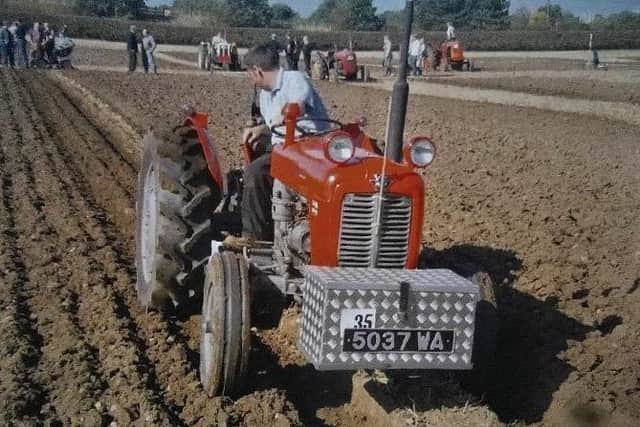Chief Executive Officer lifts the lid on competitive ploughing hobby


In normal (non-Covid) times he, or another senior I Agr E HQ staff member would have travelled to Northern Ireland to conduct the business of the AGM and present an update on I Agr E’s current overall activities, policy, progress and objectives.
Due to the current restrictions, this year’s version was presented via Zoom before a presentation about his hobby of competitive match ploughing.
Career summary


Advertisement
Advertisement
Growing up on a farm, his interest in farm machinery led on through his National Diploma in Agricultural Engineering at Reaseheath College and his engineering degree at Harper Adams University. His professional career began with design and development of chemical spray equipment before joining JCB as a design engineer on the Loadall telehandlers. This led to his role as Chief Engineer for 11 years on the Fastrac range and then on the Back Hoe Loaders for a further four and a half years. As well as his role in the UK he also travelled to work with the various JCB factory teams in Brazil, India, China to name a few!
One of his main hobby interests is competitive match ploughing with participation in 20 or more events each a year. He started during his teens, when inspired by his uncle, a keen match competitor, and hence the presentation of “Competition ploughing in the UK“.
Evolution of the plough
The tradition of turning the soil for cropping goes back for 1000s of years, as mentioned in the bible, when basic wooden implements were drawn by animals. Evolution to the ploughs of today has been based on the availability of metal products and the developing technologies around the tractors to pull and control them. By the 1700s the first scientific comparisons were being used in developing mould board designs. The mid 1800s steam power era had steam drag ploughs winched between traction-engine-powered winches at each end of the field. With multiple-furrow right and left hand ploughs the combination was an early example of how reversible ploughs could operate in the future. Tractors with trailed ploughs were taking over by the 1900s. The Ferguson 3-point-linkage mounted, draft-controlled, plough from the late 1930s increased the efficiency, effectiveness and popularity of use with the design becoming dominant from around 1950. The latest multi-furrow ploughs now offer electronic control of most of the features previously reliant on manual adjustment and expertise.
Competition
Match ploughing began from the mid-1800s proudly demonstrating the highly-valued human skills involved in achieving straight and neat furrows on a variety of soil types. It is now an established international sport with regular National, European and World events.
Advertisement
Advertisement
The international rules for competitive match ploughing recognise the range and history of traditional skills by separating competitors across a defined range of classes. These include ploughing with horses, garden tractors, vintage and modern tractors. The ploughs include both trailed and fully mounted with the latter having classes for both conventional and reversible types. The modern ploughs, as used in World class events, can use hydraulic adjustment of levelling and furrow width. At club level events the old 2 furrow basic versions are still the most popular. The Classic category includes plough designs from between 1959 and 1976 and Vintage versions are limited to basic manual adjustments only with no modifications allowed.
This means that the range of older ploughs which can be used is limited to relatively few models and those in top condition can command very high purchase prices. Some ploughs are more suitable for match work than others and the old Ransomes TS54s and their siblings are favourites in the UK. The tractors approved for use in the vintage classes are normally restricted to the basic models produced up to 1959. These classes are popular with the advantage that, for getting to and from match sites, most of the older tractors can be carried on trailers towed on the road by SUV size vehicles or equivalent.
Plot layout and quality of work
The size of plot is typically 60m X 12m but can vary between events. A maximum time to complete the work is set and quality detail of the work is all specified. Furrows must be straight and level with all vegetation buried. The ins and outs must be tidy and level with no visible wheel marks. No manual tidying of the furrows is permitted.
Skill
The real skill in using a 10” 2-furrow plough to achieve a level finished surface across the entire plot starts with the “double split opening” technique. After the straight opening furrow (achieved by tilting the plough during the first run so that only the rear mouldboard is ploughing) the adjacent furrows are then ploughed in opposite directions against it to achieve a “crown” in the centre. This must be level with the rest of the work. The furrows coming from both sides must be parallel until the desired 40” strip is left to finish against the neighbouring competitor’s plot. This needs very precise driving so early measurement, frequent checking and correction is vital over a large number of runs. The ploughing depth is reduced during the last four to five runs. Then the left hand tractor wheel can be run against the furrow wall when ploughing to leave a shallow 9” strip. The last run in the opposite direction turns the front furrow back. It grips the shallow soil bringing up just enough to leave the top finish level with the rest of the plot. This all requires exact driving accuracy and is not easy, especially when working against the clock!
Advertisement
Advertisement
The more recent “European style” reversible ploughing classes have similar challenges and also have to be accurate to achieve the required overall neat and accurate finish. They also have to deal with the fact that, unlike the conventional classes, the reversible plots are angled requiring the competitor to accurately match up to the adjoining furrows.
Whilst many of the Branch members have some experience of on-farm commercial ploughing few realised the skill and detail required for correct match ploughing. Now that they should know what to look for, attending local matches as a spectator, will never seem the same again !
The thought provoking presentation prompted an interactive enjoyable discussion when some of the topics raised included:
- The possible role of an assistant for marking out
- How the rules are applied
- How to qualify to compete in National events
- The makes and models of typical 2 furrow match ploughs
- Access to spares for the older ploughs
- Qualities needed to become a judge
- Dealing with different soil types and the “luck of the draw”
Advertisement
Advertisement
It was also a great way to get to know the new CEO and, wishing him well in his new post, members look forward to having the opportunity to welcome him again in person at a future Branch meeting.
The Northern Ireland Branch is now commencing the process of planning a new series of technical meeting subjects for the October 2021 to March 2022 winter season. For up to date information on these, nearer the time, please contact Branch Secretary Ian Duff ([email protected]).